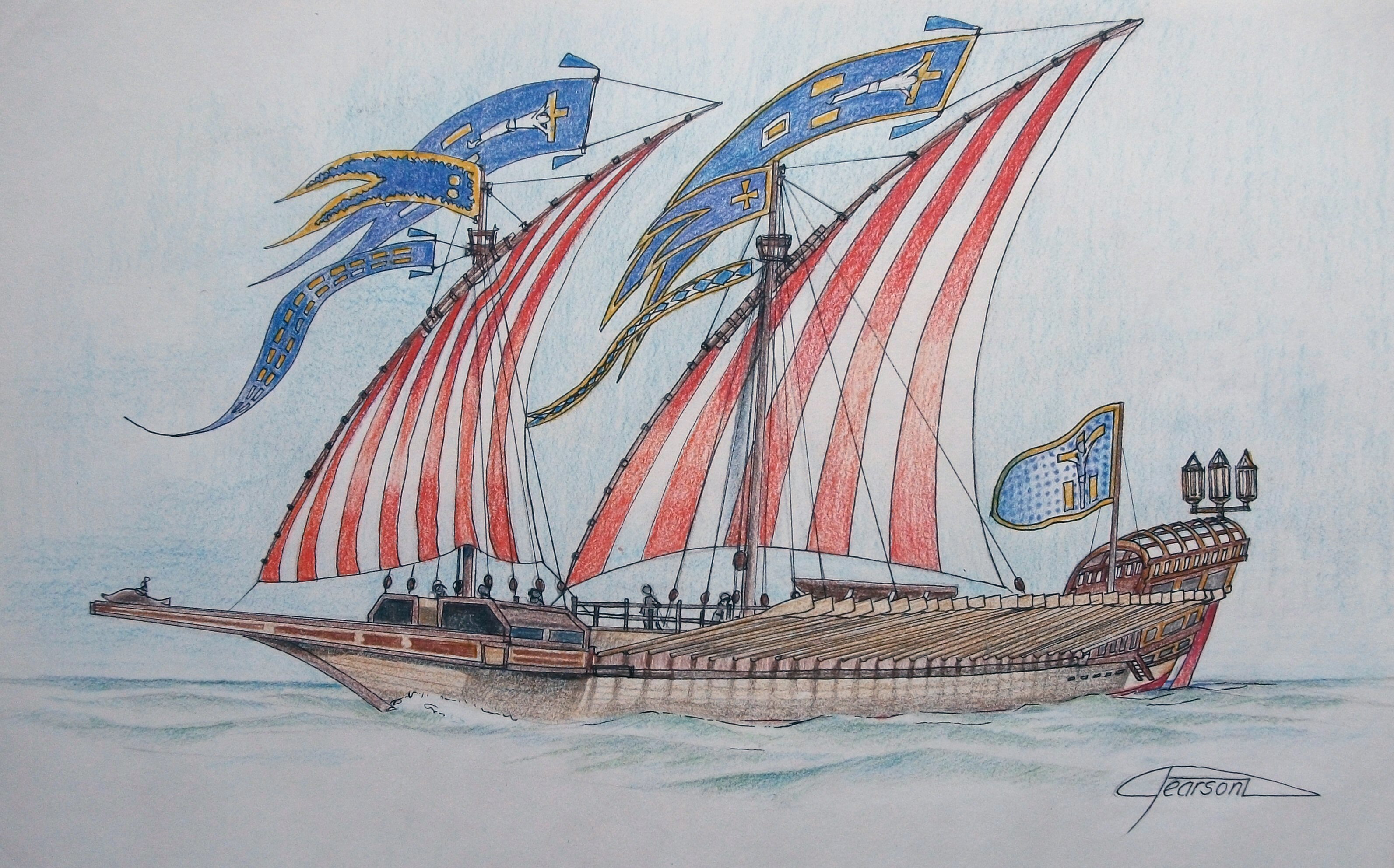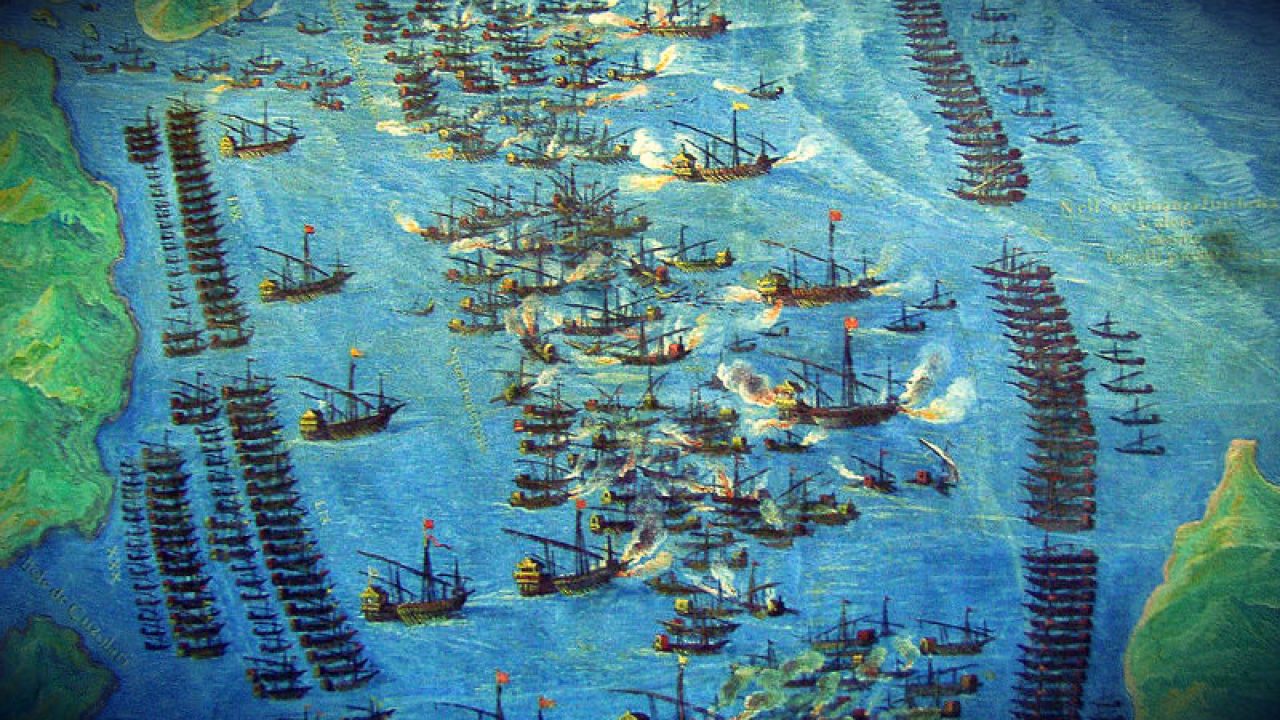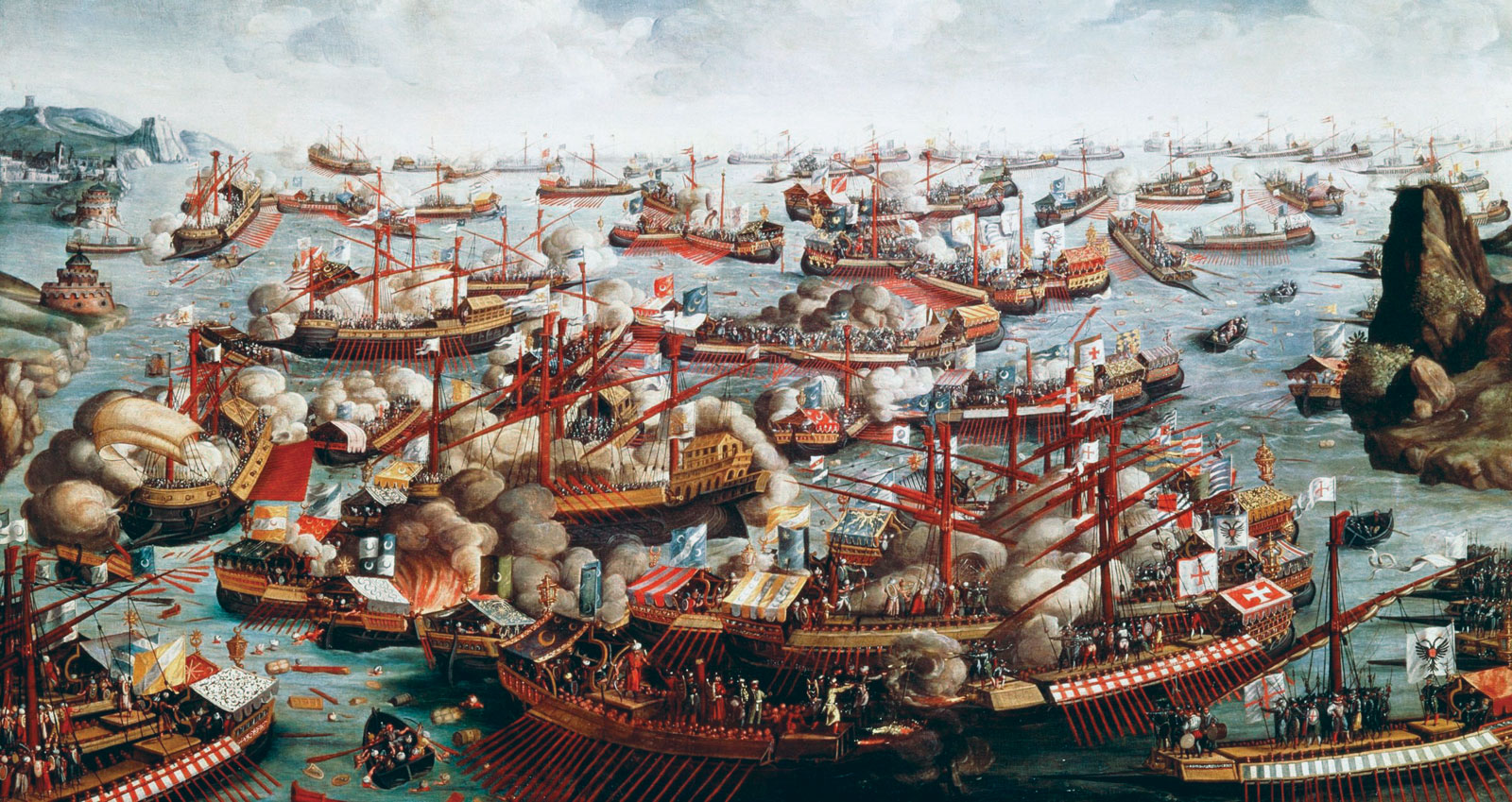In the Naval Museum in, Barcelona is a full size replica of the El Real, flagship of the Christian Holy League, which fought the Ottoman Empire’s navy of the at the battle of Lepanto. The Holy League was a desperate coalition of the Republic of Genoa, the Republic of Venice, the Spanish Empire, Sicily, Sardinia and Malta, and was led by the Pope against the mightiest Muslim navy ever assembled. The original El Real had been built and launched in Barcelona, and it was one of the largest galeasses ever constructed.

The El Real: drawing: Alan Pearson. alanpearson.pixels.com
Philip II of Spain provided most of the funds for the campaign, as well as the El Real, but Venice provided half of the ships that fought in the battle. The crusades were over, and the Moors had been driven from Spain, but they had only crossed to North Africa, from where they continued the war at sea. All of Europe learned to fear the Barbary Corsairs as they became known.
In 1453 the Ottoman Empire captured Constantinople and firmly closed all the overland trade routes to the far-east. Over decades, they had been slowly choking the sea trade with repeated attacks on Christian trading ships. They controlled all the eastern end of the Mediterranean and ports along the north coast of Africa as far as the Atlantic, and their galleys prowled the vital seaways with impunity, capturing ships and enslaving their crews for oarsmen on their galleys. Genoa, Sardinia, Corsica, the Balearic Islands and even Rome itself were attacked
The Mediterranean, or the Sea of the Moors, as it was now being called, became the most hotly contested piece of water in the world. The Ottomans began to island hop in the Aegean, forcing Venetians to abandon their ports and flee. One of their most successful captains, Kheir el Din, (protector of the faith), but better known as Barbarossa, (Red Beard) was summoned by the Sultan of Constantinople and ordered to reorganise and enlarge the Turkish navy. The outcome was an immense fleet of over a hundred galleys and many more support ships. Venice was suffering from these repeated attacks and becoming alarmed with the growing strength of the Ottoman fleet. The Doge pleaded with the other nations around the Mediterranean to form the Holy League to confront the Moors once and for all.
Venice at that time owned one of the largest commercial navies in the world. It was made up of two distinct kinds of trading ships. The tall sailing ships which had large holds and were broad in the beam were the most numerous and popular. Venice had around three hundred of these. Of these three hundred, 30 could be considered superships weighing over 250 tons. These large vessels plied the routes to the eastern Mediterranean ports bringing Syrian cotton and Cretan wine.
The other kind of ship was the galley, or if it had a sail a galeass, which normally carried around 150 oarsmen. These oarsmen were not slaves and were armed, and so the galleys that carried precious cargoes were also well defended. Many also had a rams built into the prow, which could sink or severely disable another ship. Galleys were slower than the sailing ships and required huge crews serving as oarsmen, but they were much harder to rob. A direct descendant of Greek triremes, they were the elite of the Venetian navy, and often made quite long voyages through the Straits of Gibraltar and up the coast of Portugal, calling at Lisbon and Flanders in France before stopping in England to trade.
Over the centuries, it had been the Venetian shipyards that had built the best and biggest galleys, but by the late 1400’s they were struggling to find the timber that they needed to build ships. When traders first began using the Mediterranean as a super-highway, the forests around Venice began at the shore and climbed all the way to the Alps. They contained spruce, fir, larch and beech well as other timber which had more specialised uses aboard a ship. But the most important timbers for shipbuilding was the mighty oak, whose curved boughs made the ribs, and whose straight trunks were laid and joined for the keels. But by the time of Lepanto, the abundance of forests within the Republic of Venice had been depleted to critical levels for shipbuilding. The Venetians shipwrights toured the forests marking trees that were to be used for shipbuilding and imposed strict laws about felling trees. They provided armed guards for the woodlands, which effectively made them property of the state. It was at this crucial time when timber for new ships was scarce that the Turks reached the peak of their power.

Formation of the two fleets before the battle.
The two fleets met on 7 October 1571 in the Gulf of Patras and immediately decided to engage. The Christian fleet consisted of 206 galleys and six galleasses. Ali Pasha, the Ottoman admiral, supported by the corsairs Mehmed Sirocco of Alexandria commanded an Ottoman force of 222 war galleys, 56 galliots, and some smaller vessels. An advantage for the Christians was the numerical superiority in guns and cannon aboard their ships, as well as the superior quality of the Spanish infantry. It is estimated that the Christians had 1,815 guns, while the Turks had only 750 with insufficient ammunition. The Christians embarked with their much improved arquebusier and musketeer forces, while the Ottomans trusted in their greatly feared composite bowmen. Within the first hour, the flagship of the Turkish fleet had rammed the Real and boarded her. It was only the intervention of the League ship, the Colonna that saved the day. The crew of the Colonna drove off the Turks and captured the Ottoman flagship killing all the crew including their admiral, Ali Pasha. The banner of the Holy League was hoisted on the captured ship and the morale of the Turks plummeted. Isolated battles raged for hours more, but it was obvious that the Turks were defeated. By the end of the day, the Christians had taken 117 galleys along with 20 galliots and sunk or destroyed another 50 ships. Around 10,000 Turks were taken prisoner and 20,000 Christian slaves freed, and if we can believe the figures the, Christians lost 7,500 men, whilst the Turks lost 30,000.

When stock was taken after the battle it was soon realised that nothing decisive had been achieved. None of the territories captured by the Turks had been recaptured. If the Holy League (which was already falling apart) had pressed on they could have inflicted real damage to the Turks. In effect, all that had been achieved was to draw a line down the Mediterranean that said Christendom to the left, Ottoman Empire to the right.
Six months later, with the forests of Greece and Turkey at their disposal, the Ottomans had replaced more than 150 galleys, 8 galleasses, and in total 250 ships had been built, including eight of the largest capital ships ever seen in the Mediterranean. That same year (1572) the Turks took Cyprus. The Holy League was reformed to counter the new threat, but internal divisions made it ineffective and opportunities that could have been decisive were squandered. By 1573, Venice was forced to accept loser’s terms. Cyprus was ceded to the Ottoman Empire and Venice agreed to pay an indemnity of 300,000 ducats. The Republic of Venice was still very rich, and could afford to pay the high price for the foreign timber, but her traders would have to work very hard to counter the loss of her eastern trading empire to the Turks. Fortunately, Columbus’ discovery had literally opened up a whole New World of trade opportunities which was denied to the Turks. Venice and Genoa went on to even greater riches and glory, which is evident in its art and sculpture.
However, unnoticed until the need for shipbuilding timber became acute, the whole region had undergone one of the greatest ecological disasters since the stone-age. This was not about species extinction, but the proliferation of a single species encouraged by man. The unexpected villain of this story was the hardy little goat. Let me explain.
When the replica of El Real was built it required 50 beech trees for her oars, 300 pine and fir trees for her planks and spars, and over 300 mature oaks for the timbers of her hull. To build the ships of both fleets at the Battle of Lepanto required the felling of a quarter of a million mature trees. A forest that could provide trees of the size needed for shipbuilding could easily take 300 years to grow, and in the case of oak, a figure of 500 years is more reasonable. So, over the centuries of trading, why had the forests not grown back?
Around 9,000 BC, goats and sheep were first domesticated by early farmers somewhere around Syria or southeast Turkey. Both animals are highly socially hierarchical and will follow the biggest male, making it easy to imprint them with a human master. This was an immensely successful symbiosis and was quick to be adopted by early humans. Our ancestors were discovering grain crops at about the same time, meaning that settlements became villages and the first walled towns appeared. We know this because the abundance of animal bones at the sites where these early farmers lived suddenly changed from gazelle to goat. (Domestication of the dog precedes this by at least 5,000 years.) As the idea of farming grew, both animals followed their masters and populated the shores of the Mediterranean.
The goat had evolved in an arid climate and could live on plants that were usually inedible because of thorns or because they were high up on the tree. Goats will climb trees to get at the greenery, and they are voracious feeders. If goats remain in an arid climate then this ability is an asset, but if they are introduced to mixed woodlands their appetite soon becomes a problem. They will eat saplings, thus stopping new growth. Unchecked, they will strip a forest of its undergrowth up to a height of 3 meters. As old trees are cut or die, the forest is not able to regenerate. Topsoil is washed away, and the ecosystem that is left is one that can only support the goat. Once the goat is established, the land stands little chance of recovery and the forests recede. The goat herders can hardly be blamed for allowing the expansion of an animal that provides so much and requires so little. But after 2,000 years, the rich forests around the Mediterranean had all but disappeared. Only the maquis and garrigue which had grown in the rockiest and poorest soil could survive along with the goat, and they were a worthless replacement for the forests that provided timber for shipbuilding.
Of course shipbuilding did not stop, but the timber that the shipyards needed was to come from the Baltic, where the goat had never been introduced and the forests were pristine. Spain had also welcomed the goat, and large areas of Andalucia had been stripped of forest cover. But worse was to come when Philip II ordered the decimation of whatever forests were left to enlarge his navy in order to exploit the New World and eliminate his other maritime threat, the English Corsairs. His final solution for the “English ulcer” as he called them and their virgin queen would cost him dearly in timber, in lives, and the glory of Spain. But we can’t blame the goats for that.